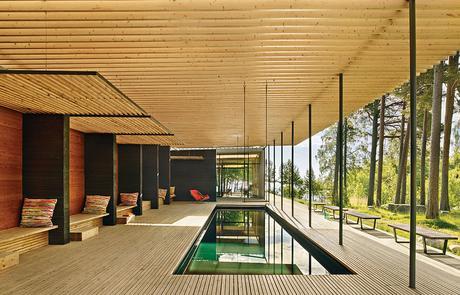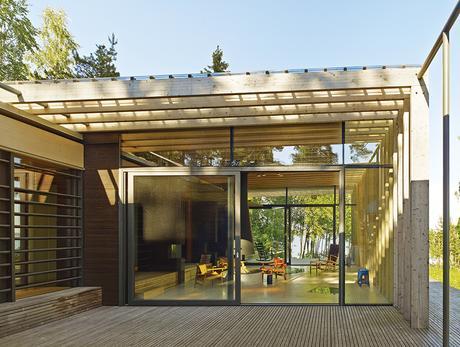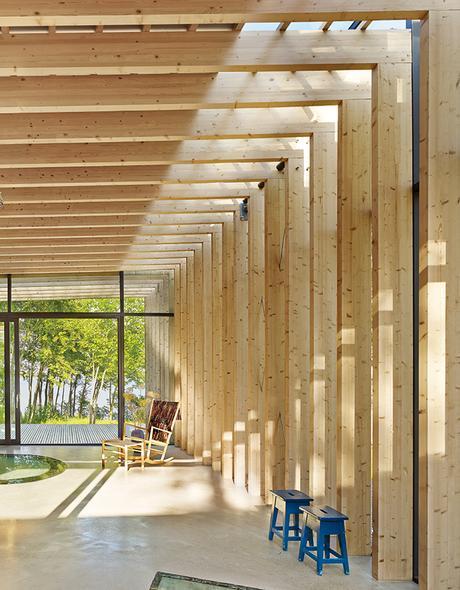
In Sweden, architect Bengt Mattias Carlsson created a pavilion adjacent to a residence dating from the late 1800s. The pergola is made from glue-laminated timber beams set atop steel posts; it protects the pool from falling pine needles. George Nelson benches offer places to sit.
Project Forest Sauna Architect Bengt Mattias CarlssonThese days, something old can easily become the next big thing—whether it’s music, fashion, furniture, or even construction methods. That’s the case with the guesthouse that Bengt Mattias Carlsson of Archie Design Lab and Meter Arkitektur designed for Linda Seitola Gunnarson, Pekka Seitola, and their two children. The family owns a large swath of land outside Gävle, Sweden, on a wooded peninsula that reaches out into the Baltic Sea. To blend the structure into the pastoral environment, Carlsson and builder Kaj Stefanius employed modern wood technology and 1,000-year-old Nordic building traditions, producing a pavilion that rests lightly on the land.
The Seitolas renovated and restored a historic house dating from the late 1800s after they bought the land nearly 20 years ago. Though the house was large enough for the family of four, the Seitolas wanted additional space to entertain friends as well as a place for bathing, recreation, and storage. They reached that conclusion shortly after finishing the renovation, but almost ten years elapsed before the guesthouse was actually built. “When we started, the kids were small,” Carlsson says. “Today they’re 17 and 20 years old.”

Light floods into the sparsely furnished living area thanks to the oversize glass doors.
The biggest obstacle was getting the necessary permits. Due to an abandoned underground military gun emplacement on the site, the family had been granted the rights to build on only a portion of the land. The heritage commission wanted the chamber preserved. “I contacted them and finally got them to agree to a bigger site,” Carlsson says. He swayed the committee by proposing to build on top of the military outpost. It still exists and is visible through glass inlays in the pavilion’s floor.
The 6,460-square-foot pavilion is one story high and nearly 200 feet long. Constructed as a series of modular spaces, it’s reminiscent of a forest cabin collection. Each space takes up 107 square feet. “It’s put together as a system,” Carlsson says. “You don’t feel it as being big, but experience it as small rooms.” The main structure includes a laundry room, guest rooms, bathrooms, and a dining-entertaining space. There are only two bedrooms, but the house can sleep ten thanks to its bunk-style interior. The four-chamber sauna is in a separate structure, as is the boathouse.
In the traditional Finnish manner (Seitola is of Finnish descent), trees have been left standing close to the pavilion, creating a visual rhythm between site and structure. Solid wooden slabs form a stage for sunbathers, and people can move freely through indoor-outdoor spaces on the spruce hardwood decking. A newly constructed road leads to the entrance on the land side, where buildings for boats, cars, and tractors have been erected.

Carlsson used the same materials and timber sizes indoors and out to maintain a unified character throughout the pavilion.
Seven-and-a-half-inch-wide hewn logs frame the structure, which rests on site-cast concrete plinths. Log construction is one of the oldest building methods in Scandinavia. “Today we talk about sustainability, but what is more sustainable than a 1,000-year-old technique?” Carlsson asks. The walls feature rough-sawn surfaces; every two-inch-wide board is tarred on the pavilion’s exterior and glazed with linseed oil inside, an eye-catching preservative treatment.
The project took a long time, but it was a happy, harmonious one. “We all worked together,” Carlsson says. “Me, the family, and the builder.” The joint effort garnered national accolades: The house won first place in the Swedish Timber Prize, a competition that is held only every four years. The jury lauded the pavilion’s exceptional “creative zest and meticulous detail.” For Carlsson, the end result “feels like a shrine.”
- Log in or register to post comments
